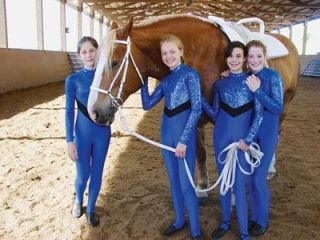STANWOOD Before she discovered equestrian vaulting, Julia Overton had spent time doing tumbling and gymnastics.
I wanted to do more than just tumbling, she said.
And through an elective course at Warm Beach Christian Camp, where Overton now attends vaulting practices three times a week, the 12-year-old discovered a sport that allows her to continue practicing gymnastics on horseback.
Overton practices with three teammates, Aurelia Carrillo, Shelby Janes and McKenna Slack, and during their hour-and-a-half practice the girls demonstrate both individual and team routines on horseback.
Their horse, Jet, wears a padded vaulting saddle with two handles near the shoulders. There are no stirrups.
As Jet maintains a trot around vaulting coach Patti Skipton, the girls gracefully mount the horse and go into a variety of positions. A common one is called the flag, in which the rider begins on her hands and knees on horseback. An arm and a leg are extended to create a parallel with the horses back.
During freestyle routines, the girls try out maneuvers incorporating the splits and handstands.
In team exercises, as many as three of the girls climb onto Jet at once. During one demonstration, Carrillo climbed onto Jet and seated herself backward near the horses shoulders and put her hands up, palms out, near her own shoulders. Janes, who had been standing on the horses back, seated herself in Carrillos hands. Janes supports Overton, who goes into a rear-facing handstand.
Its safer than it sounds, said Skipton.
The safety record for vaulting is way higher than for riding, she added.
The sport emerged from post-war Germany as a set of exercises to help horseback riders develop a more intuitive understanding of their horse. Skipton added that in that country, learning vaulting is necessary before taking up riding.
Vaulting is important because it teaches them to move in harmony with the horses, Skipton said. You dont think about it, but you cant do this without harmony with the horses.
Skipton has her vaulters on a rigorous workout schedule. Slack prepares for practice with a regimen of push-ups, crunches and running and many of the girls have barrels in their garage. With proper padding, the barrels simulate the vaulting saddle, allowing vaulters to practice their moves outside of the stable.
The first half hour of practice is dedicated to barrel work as well.
Carrillo said that though her mother had resisted her participation in gymnastics, she has been won over by vaulting.
She thinks its pretty cool, Carrillo said.
Perhaps its the extensive preparation for their time on horseback that wins safety-conscious parents over to the eye-popping sport.
For Shelby Janes mom, Valerie, the coach was a factor.
We are really, really blessed with our coach, Valerie said as she watched her daughter practice. She wont tell you, but she has national and international vaulting experience.
Because of the safety factor, Skipton said, most camps that have horses have vaulting lessons. What makes Skiptons program unique is her team is the only one in the region to compete.
They compete about once a month all over the Northwest B.C., Oregon and Washington, Skipton said, adding that her teams will be competing in regionals at the end of this month and in Denver for the nationals in August.
Though the four girls are 11 and 12 years old, Skipton teaches vaulting to boys and girls of all ages with one vaulter as young as four.
Equestrian vaulting is a more affordable sport too, as multiple vaulters often practice and compete on the same horse. Practices for this competition team are $80 a month with three practices a week.
Information about joining Warm Beach Christian Camps equestrian vaulting program is available on their web site,
www.warmbeach.com.
Not just horsing around
STANWOOD Before she discovered equestrian vaulting, Julia Overton had spent time doing tumbling and gymnastics.



